display CITROEN DISPATCH SPACETOURER 2017 Handbook (in English)
[x] Cancel search | Manufacturer: CITROEN, Model Year: 2017, Model line: DISPATCH SPACETOURER, Model: CITROEN DISPATCH SPACETOURER 2017Pages: 774, PDF Size: 48.25 MB
Page 5 of 774
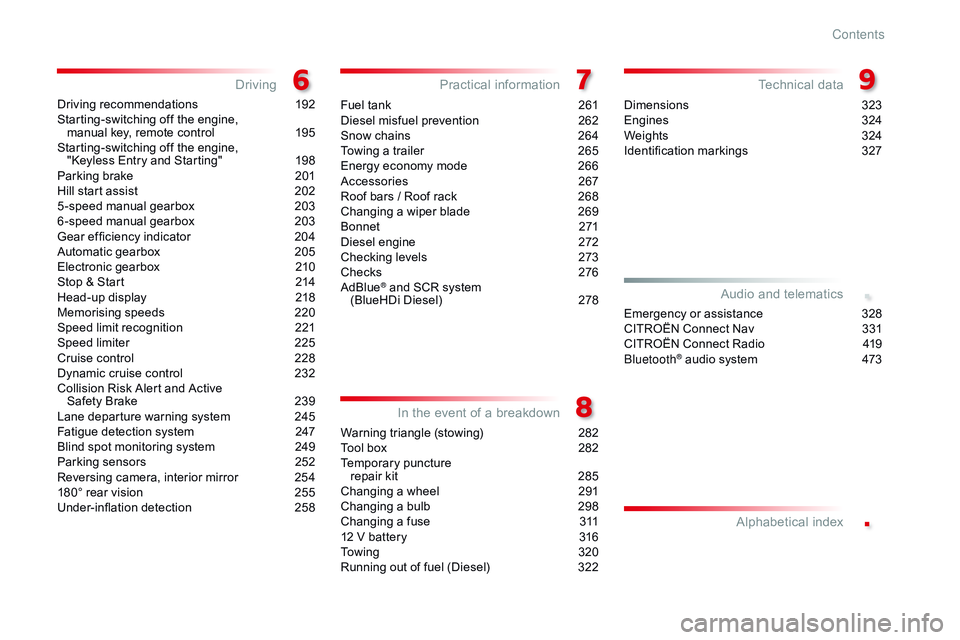
.
.
Driving recommendations 192
Starting-switching off the engine, manual key, remote control
1
95
Starting-switching off the engine, "Keyless Entry and Starting"
1
98
Parking brake
2
01
Hill start assist
2
02
5 -speed manual gearbox
2
03
6 -speed manual gearbox
2
03
Gear ef ficiency indicator
2
04
Automatic gearbox
2
05
Electronic gearbox
2
10
Stop & Start
2
14
Head-up display
2
18
Memorising speeds
2
20
Speed limit recognition
2
21
Speed limiter
2
25
Cruise control
2
28
Dynamic cruise control
2
32
Collision Risk Alert and Active Safety Brake
2
39
Lane departure warning system
2
45
Fatigue detection system
2
47
Blind spot monitoring system
2
49
Parking sensors
2
52
Reversing camera, interior mirror
2
54
180° rear vision
2
55
Under-inflation detection
2
58Fuel tank
2 61
Diesel misfuel prevention
2 62
Snow chains
2
64
Towing a trailer
2
65
Energy economy mode
2
66
Accessories
2
67
Roof bars / Roof rack
2
68
Changing a wiper blade
2
69
B o nnet
2
71
Diesel engine
2
72
Checking levels
2
73
Checks
2
76
AdBlue
® and SCR system
(BlueHDi Diesel) 2 78
Warning triangle (stowing)
2
82
Tool box
2
82
Temporary puncture
repair kit
2
85
Changing a wheel
2
91
Changing a bulb
2
98
Changing a fuse
3
11
12 V battery
3
16
To w i n g
3
2 0
Running out of fuel (Diesel)
3
22Dimensions
3
23
Engines
3
24
Weights
3
24
Identification markings
3
27
Driving
Practical information
In the event of a breakdown Technical data
Emergency or assistance 3
28
CITROËN Connect Nav 3 31
CITROËN Connect Radio
4
19
Bluetooth
® audio system 4 73
Audio and telematics
Alphabetical index
Contents
Page 9 of 774
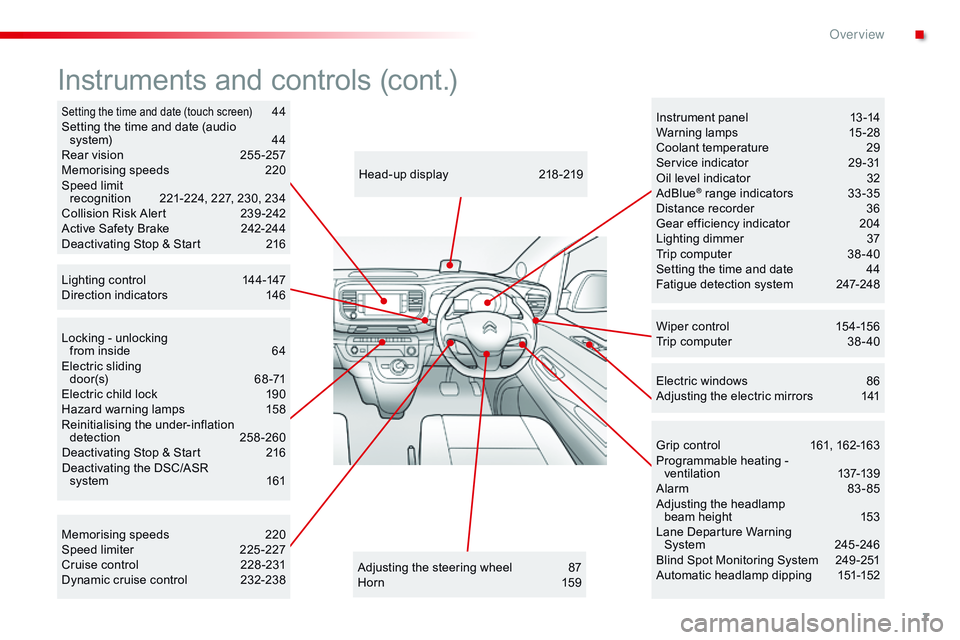
7
Locking - unlocking from inside 6 4
Electric sliding d o o r (s)
6
8 -71
Electric child lock
1
90
Hazard warning lamps
1
58
Reinitialising the under-inflation detection
2
58-260
Deactivating Stop & Start
2
16
Deactivating the DSC/ASR system
1
61Adjusting the steering wheel
87
H
or n
15
9
Head-up display
2
18 -219
Instruments and controls (cont.)
Wiper control 1
54-156
Trip computer 3 8 - 40
Memorising speeds
2
20
Speed limiter
2
25 -227
Cruise control
2
28 -231
Dynamic cruise control
2
32-238 Instrument panel
1
3 -14
Warning lamps
1
5-28
Coolant temperature
2
9
Service indicator
2
9 -31
Oil level indicator
3
2
AdBlue
® range indicators 3 3 -35
Distance recorder 3 6
Gear efficiency indicator
2
04
Lighting dimmer
3
7
Trip computer
3
8 - 40
Setting the time and date
4
4
Fatigue detection system
2
47-248
Electric windows
8
6
Adjusting the electric mirrors
1
41
Grip control
1
61, 162-163
Programmable heating - ventilation
1
37-139
Alarm
8
3-85
Adjusting the headlamp beam height
1
53
Lane Departure Warning System
24
5 -246
Blind Spot Monitoring System
2
49 -251
Automatic headlamp dipping
1
51-152
Setting the time and date (touch screen) 44
S
etting the time and date (audio
system)
4
4
Rear vision
2
55 -257
Memorising speeds
2
20
Speed limit recognition
2
21-224, 227, 230, 234
Collision Risk Alert
2
39 -242
Active Safety Brake
2
42-244
Deactivating Stop & Start
2
16
Lighting control
1
44-147
Direction indicators
1
46
.
Over view
Page 13 of 774
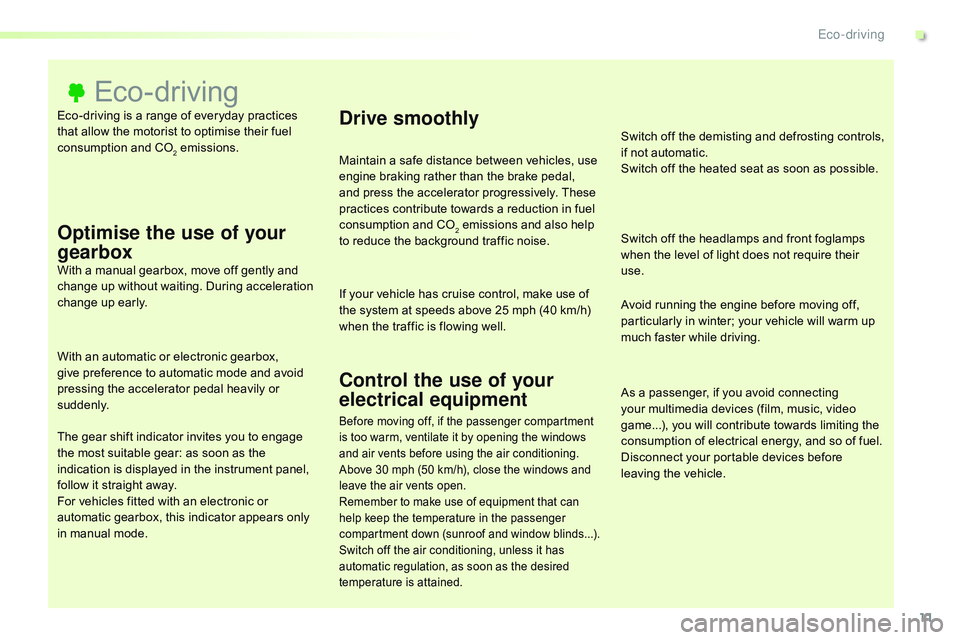
11
Eco-driving is a range of everyday practices
that allow the motorist to optimise their fuel
consumption and CO
2 emissions.
Eco-driving
Optimise the use of your
gearbox
With a manual gearbox, move off gently and
change up without waiting. During acceleration
change up early.
With an automatic or electronic gearbox,
give preference to automatic mode and avoid
pressing the accelerator pedal heavily or
suddenly.
The gear shift indicator invites you to engage
the most suitable gear: as soon as the
indication is displayed in the instrument panel,
follow it straight away.
For vehicles fitted with an electronic or
automatic gearbox, this indicator appears only
in manual mode.
Drive smoothly
Maintain a safe distance between vehicles, use
engine braking rather than the brake pedal,
and press the accelerator progressively. These
practices contribute towards a reduction in fuel
consumption and CO
2 emissions and also help
to reduce the background traffic noise.
If your vehicle has cruise control, make use of
the system at speeds above 25 mph (40 km/h)
when the traffic is flowing well.
Control the use of your
electrical equipment
Switch off the demisting and defrosting controls,
if not automatic.
Switch off the heated seat as soon as possible.
Switch off the headlamps and front foglamps
when the level of light does not require their
use.
Avoid running the engine before moving off,
particularly in winter; your vehicle will warm up
much faster while driving.
As a passenger, if you avoid connecting
your multimedia devices (film, music, video
game...), you will contribute towards limiting the
consumption of electrical energy, and so of fuel.
Disconnect your portable devices before
leaving the vehicle.
Before moving off, if the passenger compartment
is too warm, ventilate it by opening the windows
and air vents before using the air conditioning.
Above 30 mph (50 km/h), close the windows and
leave the air vents open.
Remember to make use of equipment that can
help keep the temperature in the passenger
compartment down (sunroof and window blinds...).
Switch off the air conditioning, unless it has
automatic regulation, as soon as the desired
temperature is attained.
.
Eco-driving
Page 15 of 774
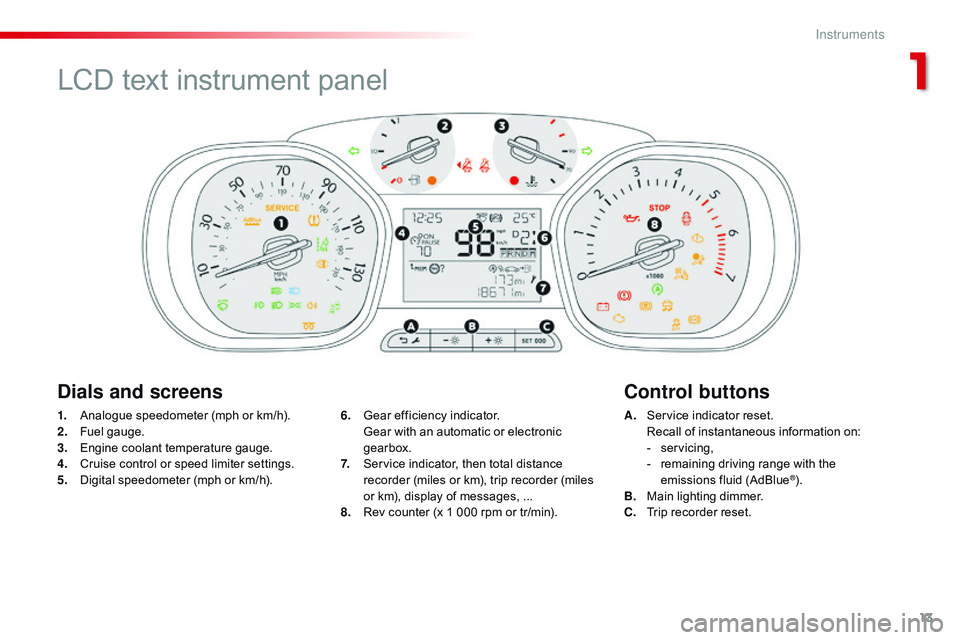
13
1. Analogue speedometer (mph or km/h).
2. Fuel gauge.
3.
E
ngine coolant temperature gauge.
4.
C
ruise control or speed limiter settings.
5.
D
igital speedometer (mph or km/h). A. S
ervice indicator reset. R
ecall of instantaneous information on:
-
ser
vicing,
-
r
emaining driving range with the
emissions fluid (AdBlue
®).
B. M
ain lighting dimmer.
C.
T
rip recorder reset.
6.
G
ear efficiency indicator.
G
ear with an automatic or electronic
gearbox.
7.
S
ervice indicator, then total distance
recorder (miles or km), trip recorder (miles
or km), display of messages, ...
8.
R
ev counter (x 1 000 rpm or tr/min).
Dials and screens Control buttons
LCD text instrument panel
1
Instruments
Page 16 of 774
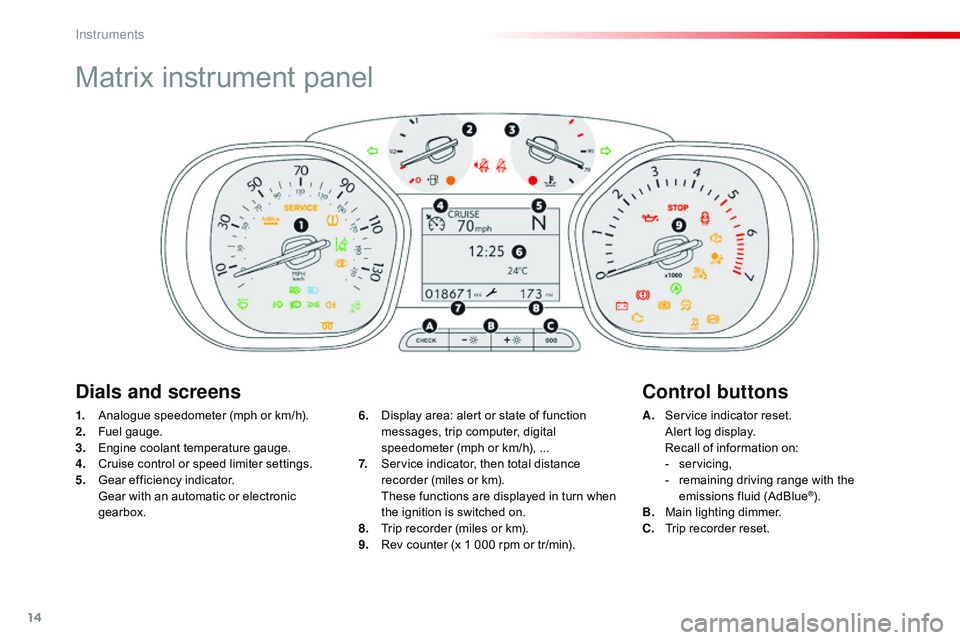
14
Matrix instrument panel
1. Analogue speedometer (mph or km/h).
2. Fuel gauge.
3.
E
ngine coolant temperature gauge.
4.
C
ruise control or speed limiter settings.
5.
G
ear efficiency indicator.
G
ear with an automatic or electronic
gearbox. A. S
ervice indicator reset. A
lert log display.
R
ecall of information on:
-
ser
vicing,
-
r
emaining driving range with the
emissions fluid (AdBlue
®).
B. M
ain lighting dimmer.
C.
T
rip recorder reset.
6.
D
isplay area: alert or state of function
messages, trip computer, digital
speedometer (mph or km/h), ...
7.
S
ervice indicator, then total distance
recorder (miles or km). T
hese functions are displayed in turn when
the ignition is switched on.
8.
T
rip recorder (miles or km).
9.
R
ev counter (x 1 000 rpm or tr/min).
Dials and screens Control buttons
Instruments
Page 17 of 774

15
Indicator and warning
lamps
Visual indicators informing the driver that
a system is in operation or is switched off
(indicator lamp), or has a fault (warning lamp).
When the ignition is switched on
Certain warning lamps come on for a few seconds
when the vehicle's ignition is switched on.
When the engine is started, these same
warning lamps should go off.
If they remain on, before moving off, refer to the
information on the warning lamp concerned.
Associated warnings
Certain warning lamps may come on in one of
two modes: fixed (continuous) or flashing.
Only by relating the type of illumination to the
operation of the vehicle can it be determined
whether the situation is normal or a fault has
occurred. In the event of a fault, the illumination
of the warning lamp may be accompanied by
an audible signal and/or a message.
Warning lamps
When the engine is running or the vehicle is
being driven, illumination of one of the following
warning lamps indicates a fault which requires
action on the part of the driver.
Any fault resulting in the illumination of a
warning lamp must be investigated further
using the associated message.
If you encounter any problems, contact a
CITROËN dealer or a qualified workshop.
Operation indicator lamps
If one of the following indicator lamps comes on
in the instrument panel and/or instrument panel
screen, this confirms that the corresponding
system has come into operation.
Deactivation indicator lamps
If one of the following indicator lamps comes
on, this confirms that the corresponding system
has been switched off intentionally.
This is may be accompanied by an audible
signal and the display of a message.
1
Instruments
Page 24 of 774

22
Warning / indicator lampStateCause Action / Observations
Passenger's
front airbag fixed in the seat belt
and front passenger's
airbag warning lamps
display. The control switch, located at the
passenger's end of the dashboard, is
set to the "OFF"
position.
The passenger's front airbag is
deactivated.
You can install a rear ward facing
child seat, unless there is a fault with
the airbags (airbag warning lamp on). Turn the control switch to the "ON"
position to activate
the passenger's front airbag; in this case, you must
not install a child seat in the rear ward facing position
on this seat.
Airbags
on temporarily. This warning lamp comes on for a
few seconds when you turn on the
ignition, then goes off. This warning lamp should go off when the engine is
started.
If it does not go off, contact a CITROËN dealer or a
qualified workshop.
fixed. One of the airbag or seat belt
pretensioner systems has a fault. Have them checked by a CITROËN dealer or a
qualified workshop.
Passenger's
airbag system fixed.
The control switch, located at the
passenger's end of the dashboard, is
at the "ON" position.
The passenger's front airbag is
activated.
In this case, do not install a rear ward
facing child seat on the front
passenger seat. Turn the control switch to the "
OFF" position to
deactivate the passenger's front airbag.
You can install a rear ward facing child seat, unless
there is a fault with the airbags (airbag warning
lamp
on).
Instruments
Page 28 of 774

26
Warning / indicator lampStateCause Action / Observations
Rear foglamps fixed. The rear foglamps are on. Turn the ring on the stalk rear ward to switch off the
rear foglamps.
Service
on temporarily. A minor fault has occurred for which
there is no specific warning lamp. Identify the fault by means of the associated message,
for example:
-
l
ow engine oil level,
-
l
ow screenwash/headlamp wash fluid level,
-
d
ischarged remote control battery,
-
l
ow tyre pressures,
-
s
aturation of the particle filter (FAP) on Diesel
vehicles.
-
...
F
or more information on Checks and in particular the
particle filter, refer to the corresponding section.
For any other faults, contact a CITROËN dealer or a
qualified workshop.
fixed. A major fault has occurred for which
there is no specific warning lamp. Identify the fault by reading the message and contact
a CITROËN dealer or a qualified workshop.
+ fixed, associated with
flashing and then fixed
display of the service
spanner.The servicing interval has been
exceeded.
Only on BlueHDi Diesel versions.
Your vehicle must be serviced as soon as possible.
Instruments
Page 32 of 774

30
Between 600 miles (1 000 km)
and 1 800 miles (3 000 km) remain
before the next service is due
For 5 seconds after the ignition is switched on, the
spanner symbolising the service operations comes
on. The distance recorder display line indicates the
distance remaining before the next service is due.
Example: 1 700 miles (2 800 km) remain before
the next service is due.
For 5 seconds after the ignition is switched on, the
screen indicates:
5 seconds after the ignition is switched on,
the spanner goes off ; the distance recorder
resumes its normal operation. The screen then
indicates the total distance.
Service overdue
5 seconds after the ignition is switched on,
the distance recorder resumes its normal
operation. The spanner remains on .
For 5 seconds after the ignition is switched
on, the spanner flashes
to indicate that
the service must be carried out as soon as
possible.
Example: the service is overdue by 180 miles
(300 km).
For 5 seconds after the ignition is switched on,
the screen indicates:
Less than 600 miles (1 000 km)
remain before the next service is due
5 seconds after the ignition is switched on,
the distance recorder resumes its normal
operation. The spanner remains on to
indicate that a service must be carried out
soon.
For BlueHDi Diesel versions, this alert may
also be accompanied by the fixed illumination
of the service warning lamp when the ignition
is on.
More than 1 800 miles (3 000 km)
remain before the next service is due
When the ignition is switched on, no service
information appears in the screen. Example:
560 miles (900 km) remain before
the next service is due.
For 5 seconds after the ignition is switched on,
the screen indicates:
Instruments
Page 33 of 774

31
The distance remaining may be
weighted by the time factor, depending
on the driving conditions.
Therefore, the spanner may also come
on if you have exceeded the period
since the last service, indicated in the
manufacturer's service schedule.
For BlueHDi Diesel versions, the
spanner may also be brought on earlier
than expected, depending on the
degree of deterioration of the engine oil
(depending on the country of sale).
The rate of deterioration of the engine
oil depends on the driving conditions in
which the vehicle is used.Resetting the service indicatorIf you have to disconnect the battery
following this operation, lock the vehicle
and wait at least five minutes for the
reset to be registered.
You can access the service information at any
time.
After each service, the service indicator must
be reset to zero.
If you have carried out the service on your
vehicle yourself, switch off the ignition:
Retrieving the service
information
F Press and hold this button,
F
S
witch on the ignition; the distance
recorder display begins a countdown,
F
W
hen the display indicates "=0" , release
the button; the spanner disappears. F
P
ress this button.
The service information is displayed for a few
seconds, then disappears.
1
Instruments